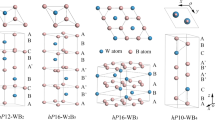Conclusions
With increasing grain size a transition takes place from intercrystallite to dual-type (inter- and transcrystallite) fracture. The two-phase Geksanit-R is characterised by the smallest grain size, a uniform grain size, and the lowest inclusion and pore contents. It is to these characteristics that the material owes its high hardness and excellent fracture toughness (Kc≈50–55 kgf/mm3/2); its effective energy of fracture, y ≈ (6.2–7.5)·104 ergs/cm4, is an order greater than its true surface enrgy γo. The hardness of Geksanit-R sinterings is virtually independent of the ratio between the relative amounts of BNw and BNs. The presence in Geksanit-R specimens of 2–7% of graphitelike boron nitride embrittles the material, without substantially altering its hardness. The other BNs-base superhard materials (including Elber-R, Belbor, and PTNB-IB-1) are less hard than Geksanit-R, which is attributable to their larger grain size and the presence of foreign substances and phases, and exhibit a marked tendency toward brittle rupture.
Similar content being viewed by others
Literature cited
E. S. Bogorodskii, Yu. L. Aparnikov, and B. M. Sokolovskii, “Dependence of the useful life of a tool from polycrystalline cubic boron nitride on its physicochemical properties in the cutting of difficult-to-machine materials,” Almazy Sverkhtverdye Mater., No. 5, 6–9 (1977).
M. F. Semko, V. P. Zubar', G. G. Karyuk, et al., “Operating performance of Geksanit-R tools in the lathe-machining of quenched steels and heat-resisting alloys,” in: Geksanit and Geksanit-R and Tools Made of Them [in Russian], Kiev (1974), pp. 50–56.
A. G. Evans and T. R. Wilshaw, “Quasistatic solid particle damage in brittle solids. I. Observations, analysis and implications,” Acta Metall.,24, 939–956 (1976).
A. G. Evans and E. A. Charles, “Fracture toughness determinations by indentation,” J. Am. Ceram. Soc.,59, No. 7–8, 371–372 (1977).
V. A. Borisenko, A. K. Butylenko, O. N. Grigor'ev, Yu. V. Mil'man, and V. I. Trefilov, “Effect of temperature and high pressure on the mechanical properties of diamond,” in: Synthetic Diamonds — a Key to Technical Progress [in Russian], Part 1, Naukova Dumka, Kiev (1977), pp. 330–337.
O. N. Grigor'ev, Yu. V. Mil'man, V. N. Skvortsov, et al., “Resistance of covalent crystals to microindentation,” Poroshk. Metall., No. 8, 72–80 (1977).
A. V. Bochko, O. N. Grigor'ev, S. S. Dzhamarov, et al., “Temperature dependence of the hardness of boron nitride,” Poroshk. Metall., No. 6, 64–69 (1977).
Fed. Ger. Rep. Pat. No. 2111180 (1972).
Franch Pat. No. 2098009, June 23, 1977.
Fed. Ger. Rep. Pat. No. 2235240 (1972).
U.S. Pat. No. 3876751, Apr. 8, 1975.
E. F. Dolgopol'skaya et al., “Dependence of the strength of synthetic diamonds on their density,” Summaries of Papers to an All-Union Conference on New Developments in the Theory and Practice of Production and Application of Synthetic Superhard Materials in the National Economy [in Russian], Kiev (1977).
A. G. Evans, “Energies for crack propagation in polycrystalline MgO,” Phil. Mag.,22, No. 178, 841–852 (1970).
J. F. Nott, Principles of Fracture Mechanics [Russian translation], Metallurgiya, Moscow (1978).
R. J. Stokes, “Microscopic aspects of the fracture of ceramics,” in: Fracture [Russian translation], Vol. 7, Mir, Moscow (1976), pp. 119–220.
T. K. Gupta, “A qualitative model for the development of tough ceramics,” J. Mater. Sci.,9, No. 10, 1585–1589 (1974).
H. Hubner and W. Strobl, “Anwendbarkeit bruchmechanischer Verfahren auf keramische Werkstoffe,” Ber. Deut. Keram. Ges.,54, No. 12, 401–404 (1977).
Author information
Authors and Affiliations
Additional information
Translated from Poroshkovaya Metallurgiya, No. 10(202), pp. 61–69, October, 1979.
Rights and permissions
About this article
Cite this article
Bochko, A.V., Grigor'ev, O.N., Dzhamarov, S.S. et al. Effect of structural factors on the mechanical properties of superhard materials based on boron nitride. Powder Metall Met Ceram 18, 729–736 (1979). https://doi.org/10.1007/BF00797446
Received:
Issue Date:
DOI: https://doi.org/10.1007/BF00797446




